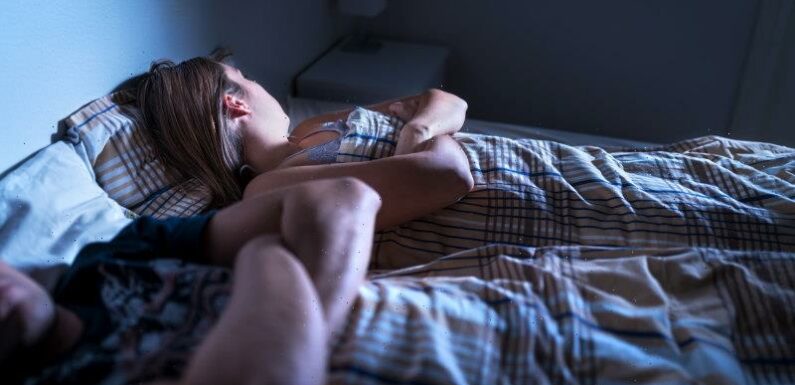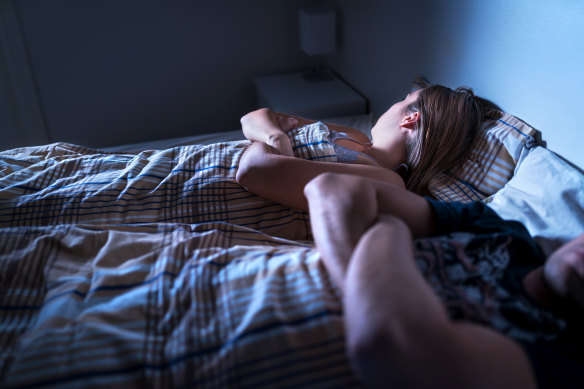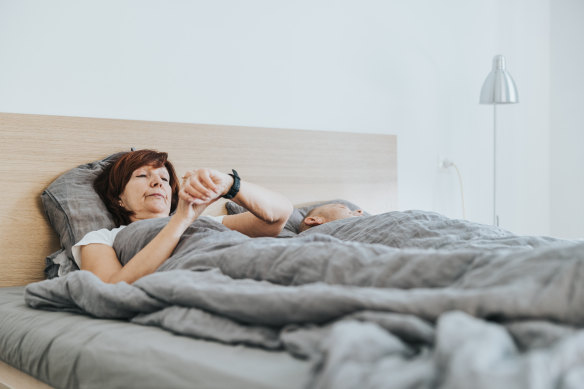
My name is Melissa Twigg and I am a night tyrant. According to my husband, Christopher, anyway. He assures me that by day I am a mostly pleasant person to live with, but once we climb into bed, my tyrannical side comes out – and not in a sexy way. Charges against me include demanding he goes to sleep when I do, prodding him if he makes a noise, and insisting he talks to me after we turn the light off (while getting upset if he accidentally wakes me up).
This admittedly annoying behaviour comes from a place of anxiety rather than natural tyranny and was sparked by my mid-30s slide from good sleeper to bad. It began a few months after we met, and the problem, I suspect, is that up to that point I had spent the majority of my adult life single – and so never fully learnt how to share a bed with someone else.
Couples struggling to sleep next to each other can improve things with some work.Credit:iStock
We are far from alone: in a study from 2017, one in four cohabiting Britons said they sometimes slept in different beds due to sleep issues, and one in 10 said they would opt for separate rooms if they had enough space. At home, a growing number of couples are opting to sleep apart. I don’t think that sleeping apart is a sign of an unhappy marriage, but I’d rather not succumb to it less than a year in (not least because we currently live in a one-bedroom flat). As a result, I was delighted to take up an invitation to the Swiss Alps, where the Alpina Gstaad has created a sleep suite that teaches the super-rich the art of drifting off.
In early December, Switzerland was carpeted in a thick layer of snow, and half an hour after arriving, we were swimming outside in a heated pool ringed by mountains. If I can’t sleep here, I thought – snow flurries falling on my eyelashes – I can’t sleep anywhere.
The hotel itself is magnificent. Built for a cool $489 million, it is perched on a hill above Gstaad, and each room has an expansive balcony with views of either the town or the ski slopes. Our suite was vast, with wooden walls, cashmere throws and a fire that turned on at the flick of a switch. If The White Lotus did snow, this would be it.
Dotted around our suite were signs that we were here for self-improvement rather than pure luxury. On a table were tinted glasses, CBD oil, herbs for the bath and a bed with a remote control – but we were hungry and ignored the health tech for delicious food in the restaurant downstairs. Afterwards, Christopher fell asleep immediately, while I anxiously clock-watched, and eventually took a Nytol tablet at 2am.
The next morning, we went skiing. We are both dreadful skiers, but the landscape was so beautiful that even snowploughing down a blue run, as Swiss three-year-olds hurtled past us, felt magical. But sleep rather than snow was the order of the day, and our instructor had us back by lunch to start training for the one thing at which I am even less talented than getting down a mountain.
Our first visitor was a grey-haired man in a pistachio-green monk’s robe. Antonis Serris is the head therapist at the Alpina’s vast Six Senses spa, which boasts a Himalayan salt grotto that is designed to recreate the sensation of being in the womb.
He squeezed our hands and explained that ours was a common issue. “After doing this job for years, I can tell you that it’s usually the sleeping part that people in new marriages find difficult, not the sex part.”
Following a series of questions about our routine, our meals and our exercise habits, Serris – who is trained in Tibetan medicine – diagnosed our bed as being too small, our 8.30pm dinner as being too late and me as having too much wind (not in that way) and my husband too much heat. Put heat and wind together and, apparently, a bushfire can ignite.
At points it was hard not to laugh, but – vivid imagery aside – much of what he said felt true. Wind (again, no) is a bit like anxiety, but it can often be soothed before it turns gale force with a hug and a chat. Heat, by contrast, likes to be undisturbed.
One key move is to buy separate doonas.Credit:iStock
We both had to give each other a bit of what we wanted, while respecting our own boundaries, and I was told that instead of dashing off to the sofa on a sleepless night, I needed to associate our bed with relaxation. “Take it easy,” said Serris. “In the olden days, people used to wake up in the middle of the night – it’s normal. Don’t get frustrated and worried, instead comfort yourself and say, ‘When it comes, it comes.’”
I found this surprisingly helpful. The world has shifted from admiring Margaret Thatcher types to fetishising sleep, and hearing a professional essentially say “it’s no big deal” relaxed me more than the CBD oil. Serris also prescribed me warm soup, ginger tea and yoga. For Christopher’s heat, no gluten, beer or sugar, which I found amusingly drastic. Serris pointed to the tinted glasses on his way out and explained that they were designed to block out blue light. “Tonight, you will wear these from 7pm.” We nodded dutifully.
Our next appointment was with a young woman who guided us through yoga nidra. Taught as a part of yin yoga, it focuses on movements designed to create stillness in the body. We stretched and lay on our backs as she guided us through an imaginary valley that should take us to a place between sleep and wakefulness.
Christopher started snoring almost immediately. I can’t say this helped me visualise the fairy-tale valley, as I spent half the exercise wondering whether poking him would be frowned upon in a sleep suite. Afterwards, he was praised for truly entering into the spirit of things, and while I was definitely the failure student, I did find the breath work soothing.
Instead of leaving us to our own devices in the restaurant, dinner that night was in the room – a supposedly somniferous affair of lobster tartare with lime followed by a vegetable salad with seared beef and a pineapple carpaccio; all ingredients that are easy for the body to digest. Notably, the portions were smaller than usual and the food arrived at 7pm.
We cheated twice – we weren’t allowed alcohol, but persuaded the waiter to bring us a bottle of wine. We were also supposed to have the television removed, but that evening coincided with the England vs France quarter-final of the World Cup, so instead we watched the match in our Bono-like shades, which gave the room – and the players – a much-needed comforting orange hue.
Soon, it was time for the moment of truth. I turned on the FreshBed, which reacts to individual body temperature and heats each side of the bed separately, and said to my husband, “I’m worried I won’t sleep tonight.” Five minutes later, I was snoring and the next time I was conscious it was 8am. This is very unusual for me. The next day, a similar routine was repeated, and the following night I slept for eight hours again. By the time we got back to London, I felt more relaxed about sleep than I had in ages.
I’m not going to pretend that my issues have vanished and I’m sure the mountain air had something to do with it – but I did learn a few important lessons. Doing a calming yoga class after work has become part of my routine, as have the tinted shades, by Swanwick, which I now wear to read my book in bed.
The smart bed at the Alpina allowed us to share a mattress despite not sharing an inner thermostat, and while we can’t currently afford to buy a whole new model, we have swapped our double duvet for two separate singles – mine much thicker than his – and have found that we rarely wake up. “People don’t realise this, but being too hot or too cold is – after stress – the number one reason why we wake in the night,” explained Hester Noorman, the COO of FreshBed.
But, paradoxically – despite the serious Swiss approach – the most important lesson I learnt was to take it all a bit more lightly. On that first afternoon, Serris explained that instead of convoluted (and undeniably annoying) bedtime routines that remind you of your sleep issues, the best thing you can do is stay up until you feel tired, let your partner nod off without you, and tell yourself that one bad night isn’t the end of the world. Inevitably, as soon as I stop worrying, I conk out.
Has the night tyrant finally been exorcised? For both our sakes, I really hope so.
How to sleep better as a couple
- If your partner snores, use wax earplugs, which block more sound than foam ones. The non-snorer should consider going to bed first, as snorts and wheezes are less likely to wake us once we’re in a deep sleep
- Most people sleep best between 16C and 18C, but everybody is different, so consider separate duvets. This Scandinavian norm is also a lifesaver for anyone married to a blanket-hogger
- If you are investing in a new bed, opt for the biggest size your room will allow, as numerous studies have shown that couples almost always sleep better on wider mattresses
- Follow your natural sleeping patterns as much as you can. If you’re determined to go to bed at the same time, compromise – night owls could try blue-light glasses to make them sleepy, while early birds could use a face mask to stop them waking at dawn
- Be thoughtful – if you can’t sleep, go and read in another room, and try not to toss and turn too much. I’ve learnt that provoking an argument is more likely to keep you awake than anything else
This article was first published in The Telegraph, London
Make the most of your health, relationships, fitness and nutrition with our Live Well newsletter. Get it in your inbox every Monday.
Most Viewed in Lifestyle
From our partners
Source: Read Full Article

